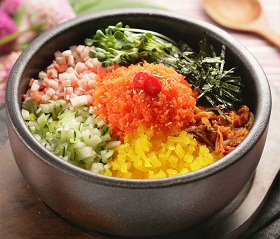 |
| |
AL-BOP
Fish Roe/Caviar And Vegetables On Rice 알밥 | ||
Albop is a popular rice dish that consists of delicate fish roe (or caviar) along with various vegetables, and steam white rice in a steaming hot ceramic called ttukbaegi or in a stone pot called dolsot. It's a simple, healthy meal which all of its content ingredients are mixed in together much like the popular Korean rice dish bibimbop but it may include other seafood ingredients such as crab meat and/or dried, shredded lavers
Similar to bibimbop, cooked vegetables such as daikon radish (donmoogee), cucumber, carrots, mushrooms, and radish sprouts may be present, depending on the restaurant or one's cooking preference. At home, certain vegetables/garnishes may be added or omitted depending on the availability or taste bud but the finished product will be a delicious, especially with the crispy toasted rice at the bottom of the bowl.
|
| FEATURED ITEMS: CLICK & SHOP |
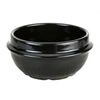 | 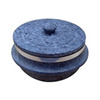 |
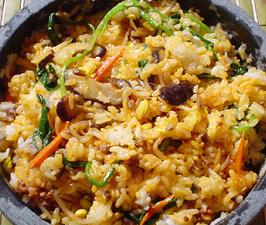 |
| |
BI-BIM-BOP
Beef & Mixed Vegetable Rice 비빔밥 | ||
Bibimbop literally means mixed rice or mixed meal in Korean. It's a popular meal consisting of a bowl of steamed white rice topped with vegetables, beef, a whole egg, and gochujang (red chili pepper paste). Gochujang is usually served separately to control its spiciness of this rice dish.
A variation of this dish, dolsot bibimbop (dolsot meaning stone pot) is served in a heated stone bowl, in which a raw egg is cooked against the sides of the bowl. Before the rice is placed in the bowl, the bottom of the bowl is coated with sesame oil; consequently, the portion of the rice touching the bowl becomes golden brown and crispy.
Vegetables commonly used in bibimbop include julienne cucumber, zucchini, carrot, white radish, mushrooms, bellflower root (gaji namul), and laver. It may also contain spinach, soybean sprouts, and bracken fern stems (gosari namul). Tofu, either plain or sautéed, may also be included in the dish as well. Within both types of bibimbops, all ingredients are typically stirred together thoroughly before eating.
|
| RECIPE INGREDIENTS |
|
| COOKING DIRECTIONS |
|
| FEATURED ITEMS: CLICK & SHOP |
 | 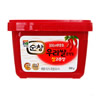 |  | 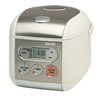 | 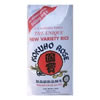 |
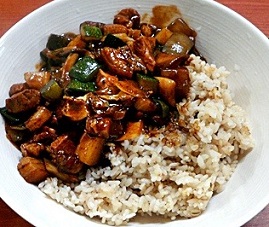 |
| |
CHA-JANG-BOP
Black Bean Paste & Vegetable With Rice 짜장밥 | ||
Chajangbop is a delicious rice dish spun off from chanjanmyun where black bean paste is mixed in with white steamed rice, bop, instead of noodles. Chajang is the sauce made from black bean paste which gives its distinctive black color and its sauce mixture containing chopped onions, potatoes, carrots, meat and seafood, usually squid, shrimp, and sea cucumber. Some starch is added to give it a thick consistency and it is served over rice.
It's a popular rice dish usually served at Chinese/Korean restaurants but you can also order a side takeout of chanjang to be enjoyed at home. Instant packages of chajang mix are also readily available at Korean supermarkets make chajangbop. Common side dish usually found alongside chajang bop is donmoogee which is pickled daikon radish.
|
| FEATURED ITEMS: CLICK & SHOP |
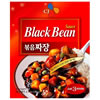 | 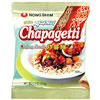 |
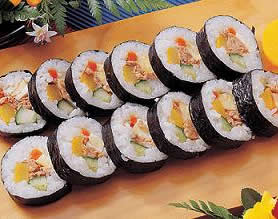 |
| |
GIM-BOP
Korean Style Sushi Roll 김밥 | ||
Gimbop is considered one of the most popular and nutritious Korean meal. It consists of rice and strips of vegetables, egg, and meat, rolled in laver (dried seaweed) and then sliced. This is a popular snack or lunch that can be made with infinite variety of ingredients using different kinds of meat and/or vegetables. Popular ones include bulgogi, spinach, pickled radish, and eggs.
At first glance, gimbop often resembles a Japanese maki or a sushi roll. However, there are a few differences between the Japanese sushi roll and the Korean-style gimbop. The main difference is that Japanese sushi rolls are rather minimal in ingredients. Sushi rolls usually consists of just tuna or salmon within the roll whereas gimbop contains a variety of ingredients as mentioned earlier. Also, while the Japanese use raw fish (sashimi) in their sushi rolls, Korean gimbop do not contain any raw fish. Lastly, Japanese sushi is often dipped in wasabi while gimbop usually has sesame oil.
Korean 101: Gim refers to the sheets of dried seaweed, and bop is the Korean word for cooked rice.
|
| RECIPE INGREDIENTS |
|
| COOKING DIRECTIONS |
|
| FEATURED ITEMS: CLICK & SHOP |
 |  | 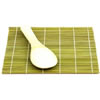 | 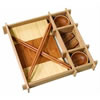 | 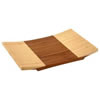 |
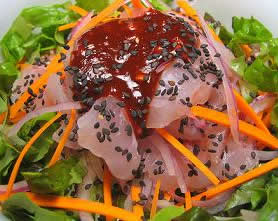 |
| |
HWEH DUP-BOP
Sashimi W/ Rice & Vegetables 회덮밥 | ||
Hweh dupbop is one of many dishes that combine abundant ingredients that Koreans enjoy and if you love sushi, you'll also enjoy this dish very much. It contains raw fish (usually salmon), white steamed rice, fresh vegetables such as green leaf lettuce, carrots, cucumber, onions and many more, mixed with a gochujang-based sauce called chojang. This big bowl of sushi-grade raw fish, vegetables, and rice is served with a spicy-sweet chojang, so that diners can mix it to their personal spice levels.
The basic ingredients of chojang are gochujang and rice vinegar which is usually a traditional accompaniment to eating raw fish in Korean cuisine. Hweh dupbop is a perfect meal during the summer and some restaurants may add slices of Korean pears which can complement its overall flavors during the hot weather.
When preparing at home, salmon can be substituted with a variety of fish such as tuna, yellowtail, and red snapper. However, the fish should be sushi-grade and very fresh which can be found in Korean or Japanese markets.
|
| FEATURED ITEMS: CLICK & SHOP |
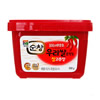 |  |  |  |
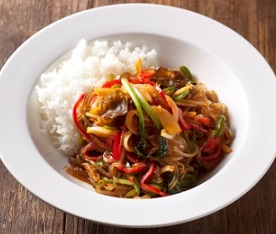 |
| |
JAP-CHAE BOP
Stir-Fried Vermicelli Noodles With Vegetables And Rice 잡채밥 | ||
Japchaebop is a delicious rice dish spun off from japchae where its stir-fried vermicelli noodle with its meat and vegetable contents are all mixed in with white steamed rice, bop. The original japchae is prepared with carrots, green onion, spinach, shiitake mushrooms and green peppers. Beef may be added as an option but may be left out to be served as a vegetarian dish. The noodles are gray when raw and turn almost translucent when cooked (thus given its popular nickname, glass noodles). When cooked correctly, they retain a chewy texture. It is usually available at traditional Korean restaurants but commonly eaten at home from left over japchae served at parties or during special occasions as the main dish.
|
| FEATURED ITEMS: CLICK & SHOP |
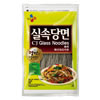 |  |  |
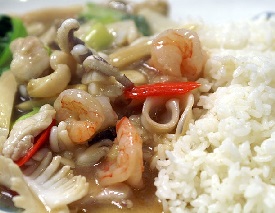 |
| |
JAP-TANG-BOP
Stir-Fried Seafood With Rice 잡탕밥 | ||
Japtangbop is a delicious rice dish made with an assortment of seafood that are stir-fried in a clear, thick sauce usually made with corn starch. It is then served alongside a bed of steamed white rice (bop) and mixed altogether before eating. It's a popular rice dish usually served at Chinese/Korean restaurants only and it commonly includes scallop, sea cucumber, squid, mussel, shrimp, and various vegetables such as bok choy, shiitake mushrooms, red or green peppers, baby corn and water chestnuts. Japtangbop is considered a non-spicy dish and enjoyed by seafood lover everywhere.
|
| FEATURED ITEMS: CLICK & SHOP |
 |  |  |
 |
| |
JUK
Rice Porridge 죽 | ||
Juk is a predominantly Korean porridge made of grains such as cooked rice, beans, and sesame. The most general form of juk is simply called heen juk which is made from plain white rice but numerous varieties exist. Different variations can include ingredients such bits and pieces of meats (pork, chicken and/or beef), vegetables, seafood, nuts and other grains. Being largely unflavored, it is served with a number of more flavorful side dishes, such as jutgal (nakji jutgal or ojinguh jutgal), various types of kimchi, and other forms of side dishes (banchans).
Juk is often eaten warm in Korea, especially as a morning meal, but can be eaten at any time of the day. Much like chicken soup in modern American culture, this dish is often consumed when ill but it is also considered an ideal choice of food for babies or elderlies as it is known to have nutritional benefits that can easily be eaten and digested. It is sold commercially by many chain stores in Korea and considered a common takeout dish.
|
| FEATURED ITEMS: CLICK & SHOP |
 |  | 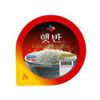 | 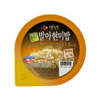 | 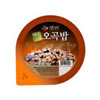 |
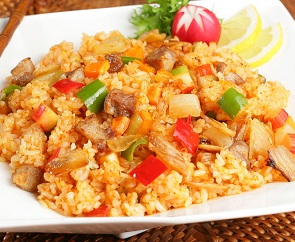 |
| |
KIM-CHI
BO-KUM-BOP Kimchi Fried Rice 김치볶음밥 | ||
Kimchi bokumbop is a popular restaurant or home prepared dish that is very simple and delicious. Usually at home, it's a way to use up kimchi before it gets too ripe to eat in which case it can also be used to prepare kimchi chigae. In Korean, bokum means sautéed or fried and bop translates into steamed rice. So essentially, kimchi bokumbop is fried rice with kimchi.
Alongside its main ingredient chopped kimchi, this rice dish can also consist of various choices in meat which is then sautéed altogether along other assortment of vegetables such as onions, garlic and bell peppers. There can be infinite variations of this bokumbop dish where beef can be substituted with little bits of galbi, bacon, spam, or even tofu.For added seasoning, soy sauce and sesame oil are added in addition to the leftover kimchi juice. Lastly, an egg is cooked sunny side up and placed on top of this rice dish for taste as well as for decoration.
|
| RECIPE INGREDIENTS: 2 SERVINGS |
|
| COOKING DIRECTIONS |
|
| FEATURED ITEMS: CLICK & SHOP |
 |  |  |  |
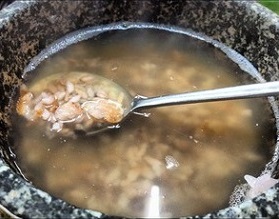 |
| |
NU-RUNG-JI BOP
Boiled Scorched Rice 누룽지밥 | ||
Nurungjibop is a traditional Korean food made of scorched rice. After boiling and serving rice in a dolsot or ddukbaegi, a thin crust of scorched rice will usually be left in the bottom of the cooking pot. This yellowed scorched state is described as nurung in Korean and nurungji derives from this adjective.
Nurungji can be eaten in its crisp state as a snack or as an after meal rice tea by adding hot water or re-boiled with water. Nurungji in its broad sense also refers to the crisp crust that forms at the bottom of the pots and pans when cooking various rice dishes such as dolsot bibimbop and bokumbop.
It is commonly served at restaurants that specializes soondooboo chigae, close to end of the meal. Also, various companies made nurungji available in a various pre-packaged forms around the mid-2000's and commercially available as snacks or instant meals.
|
| FEATURED ITEMS: CLICK & SHOP |
 |  |  |  |
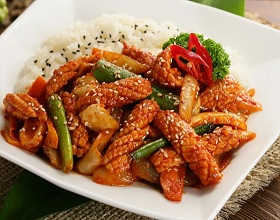 |
| |
O-JING-UH
DUP-BOP Spicy Squid Over Rice 오징어덮밥 | ||
Ojinguh dupbop is a spicy squid dish made with ojinguh bokum over steamed white rice (bop). In Korean, dupbop literally means "over rice" so fresh squids are cut into bite-sized pieces then pan stir-fried with spicy gochujang along with gochugaru and served with steamed white rice. Assortments of vegetables that can be included in the spicy sauce mix are green & red chili peppers, mushrooms, green onions, carrots and onions.
|
| RECIPE INGREDIENTS: SAUCE |
|
| RECIPE INGREDIENTS |
|
| COOKING DIRECTIONS |
|
| FEATURED ITEMS: CLICK & SHOP |
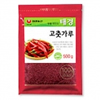 |  |  |  |  |
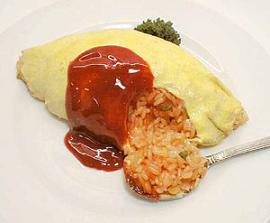 |
| |
O-MU-RICE
Omelette Fried Rice 오무라이스 | ||
Omurice is a contemporary Asian dish consisting of an omelette made with fried rice. Its name derives from the combination of the English words omelette and rice. Omurice is said to have originated from Japan and it became a popular dish at a western-style restaurant in Tokyo's Ginza district around the turn of the 19th century.
A relatively simple dish, it typically calls for rice fried with ketchup, chicken and onions wrapped in a thin sheet of fried egg. Different variations of this dish can include peas, carrots, mushrooms, green peppers, onions and kimchi. Pork or beef can be substituted for chicken as well.
|
| RECIPE INGREDIENTS |
|
| COOKING DIRECTIONS |
|
| FEATURED ITEMS: CLICK & SHOP |
 |  |  |
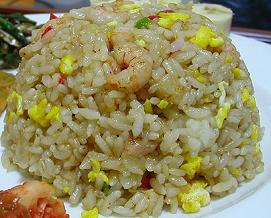 |
| |
SAE-WOO
BO-KUM-BOP Shrimp Fried Rice 세우볶음밥 | ||
Saewoo bokumbop is a popular shrimp fried rice dish that widely available in Korean/Chineserestaurants everywhere. It’s a common restaurant or home prepared dish during lunch or dinner that is quite simple but yet a fulfilling meal. It’s a fairly easy dish to prepare/cook and there are various combinations of ingredients that can be included along with shrimp. Usually, small-sized shrimps are sautéed along with chopped onions and green peas in a mixture of steamed rice, mixed with scrambled eggs and chopped green onions.
At restaurants, saewoo bokumbop is usually served with miso-typed soups, typicallychampong or egg-drop based soups.
|
| RECIPE INGREDIENTS |
|
| COOKING DIRECTIONS |
|
| FEATURED ITEMS: CLICK & SHOP |
 |  |  |  |  |
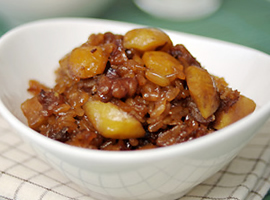 |
| |
YAK-BOP
Sweet Rice Cake 약밥 | ||
Yakbop, also known as yaksik, is a traditional Korean rice dish made from steamed glutinous rice mixed with assortments of nuts, honey and lastly, soy sauce to colorize the rice. Yakbap literally translates to "medicinal rice" in Korean and it's a very popular snack enjoyed by all ages for its delicious and nutritious benefits. Soft boiled chestnuts, pine nuts, and seedless jujubes are added to the rice mix then put into desired shapes and left to cool before eating. It is traditionally eaten during the Lunar New Year but also commonly found at Korean weddings.
Yakbop can be easily made at home but also readily available to purchase at local Korean grocery stores or supermarkets.
|
| FEATURED ITEMS: CLICK & SHOP |
 |  |  |  |  |
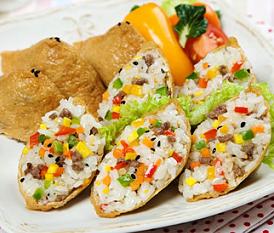 |
| |
YU-BU CHO-BOP
Soybean Curd W/ Rice 유부초밥 | ||
Yubu chobop is a Korean-styled version of a Japanese dish called inarizushi which is an unusual form of sushi where seasoned rice is stuffed in a triangular-shaped pockets made up of sweet deep-fried tofu. Ingredients can vary but pre-made instant kits are usually used when preparing this dish so no real "cooking" is involved unless fresh ingredients are additionally added. Pre-made kits contain tofu pouches or shells, seasoned mix (assortment of sesame seeds) and packets of vinegar which are readily available at local Asian groceries or supermarkets in the refrigerated section.
Optionally, some may add other fresh ingredients such as finely chopped sweet peppers, onions, carrots and/or spam to the rice mix which is usually white & sticky grain. When eaten as a whole, each stuffed shell is full of rich flavors where it’s somewhat sweet but yet a bit sour with a hint of vinegary taste but will surely please everyone’s taste buds.
Many will consider this dish as comfort food and it's great for picnics or at parties as finger food – it can be served and eaten hot or cold. If you enjoy sushi, you'll be sure to like this dish as well.
|
| RECIPE INGREDIENTS |
|
| COOKING DIRECTIONS |
|
| FEATURED ITEMS: CLICK & SHOP |
 |  |  |  |  |
No comments:
Post a Comment